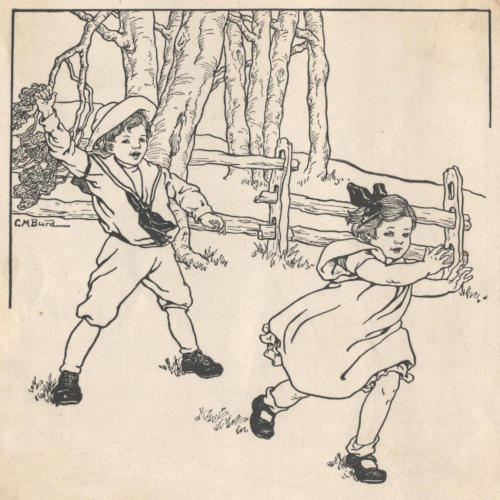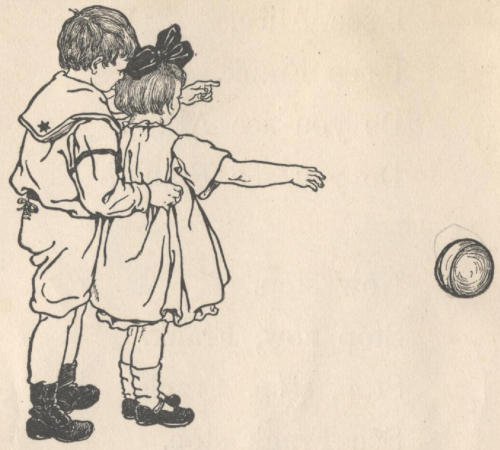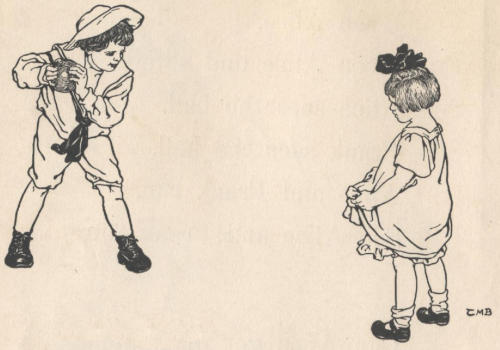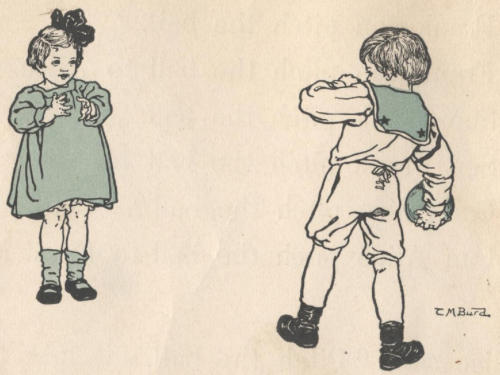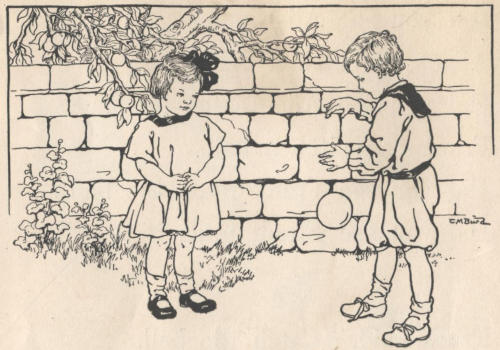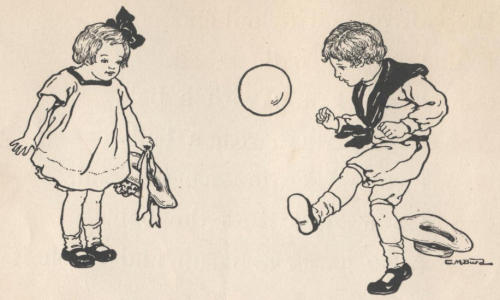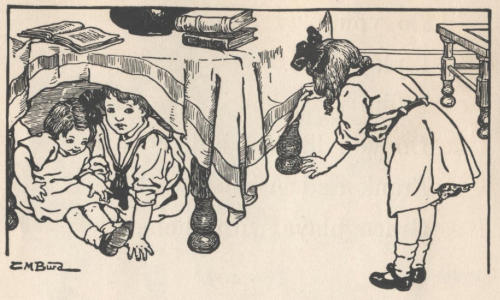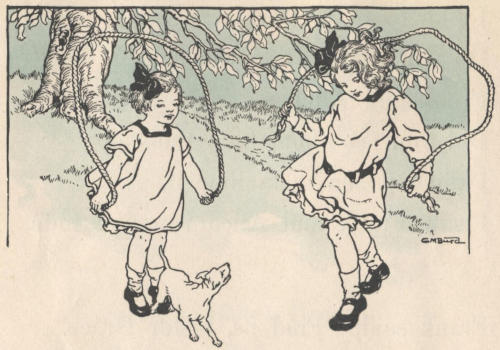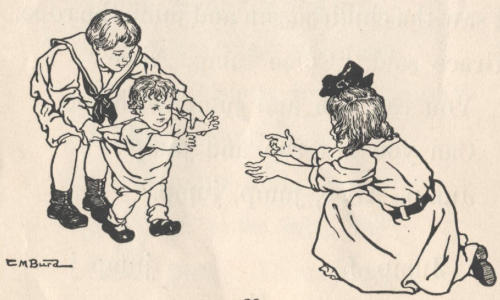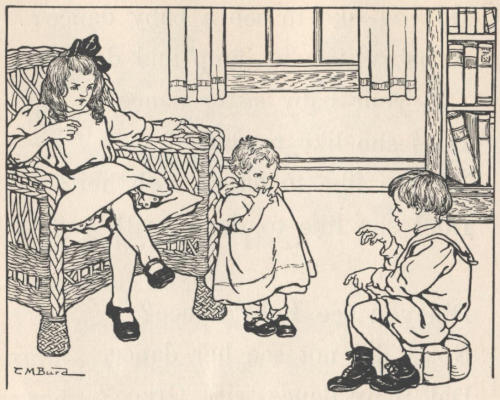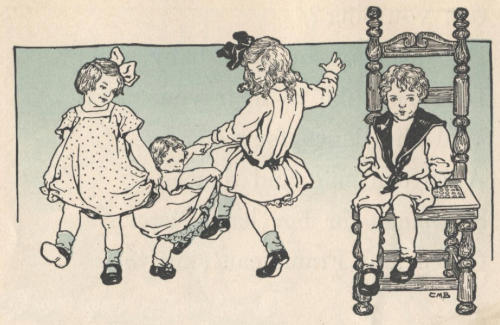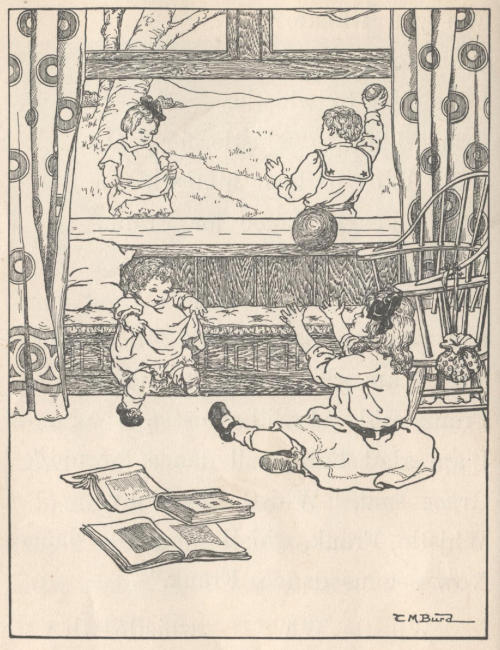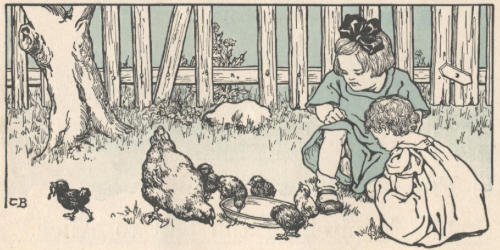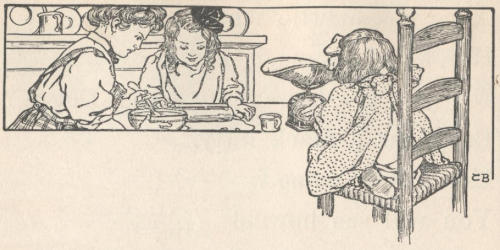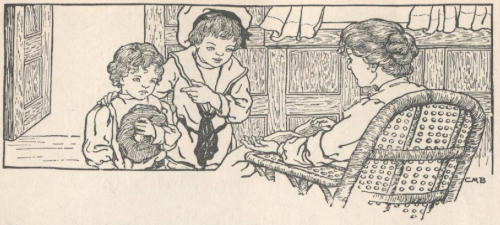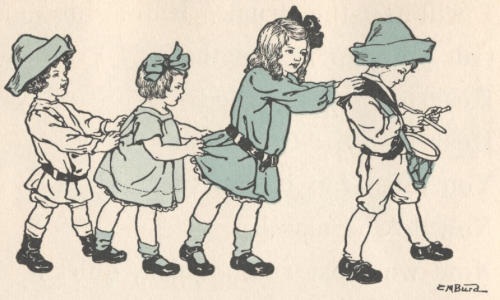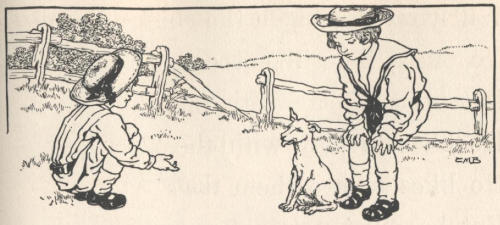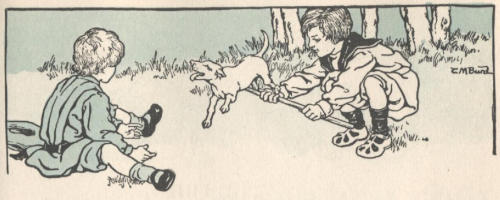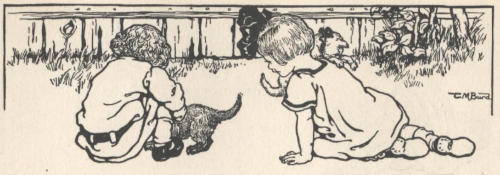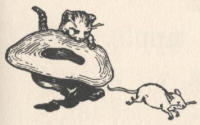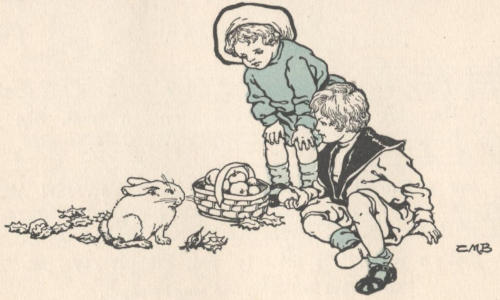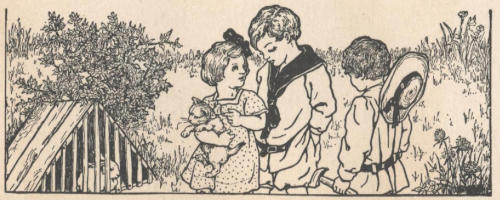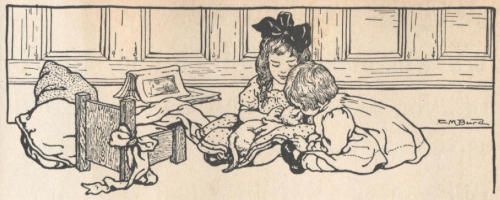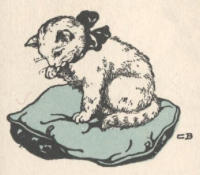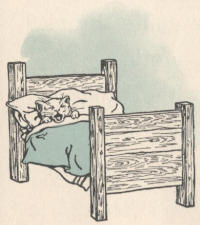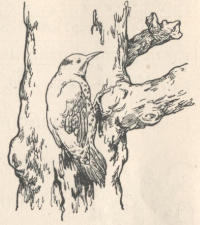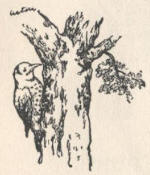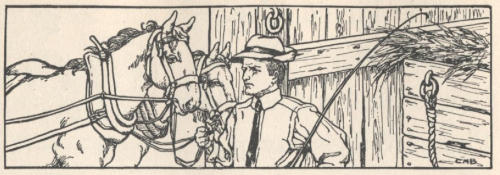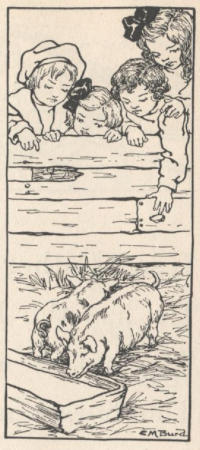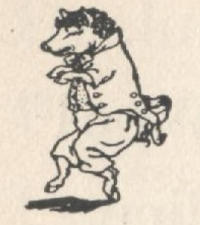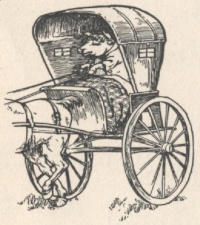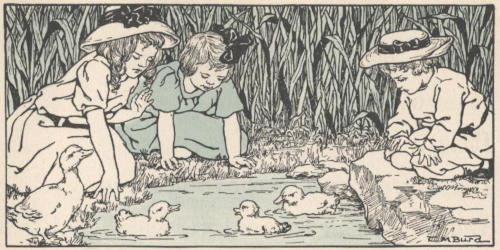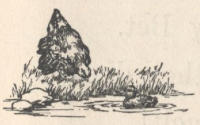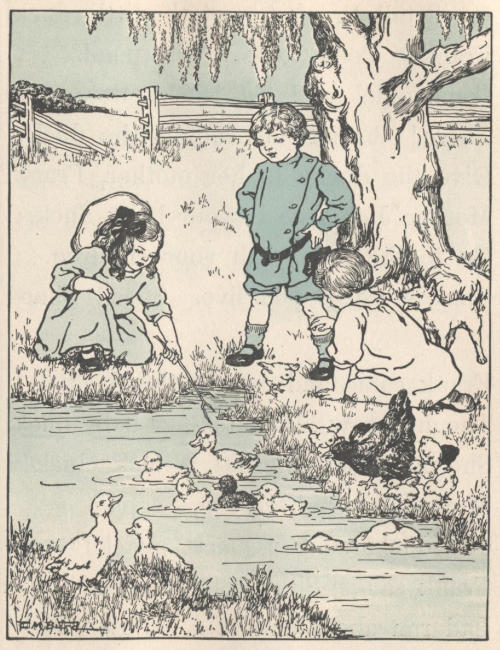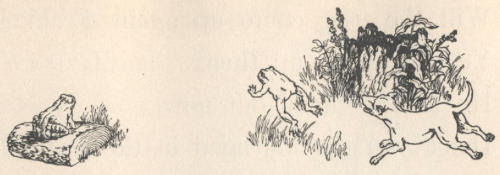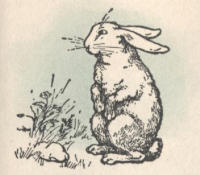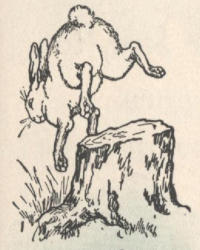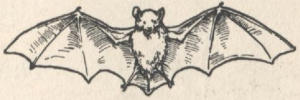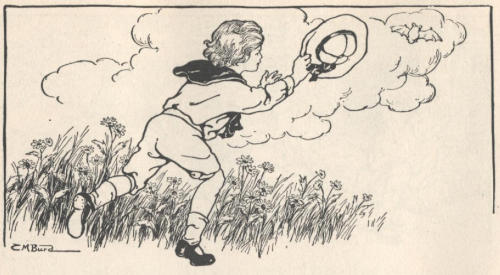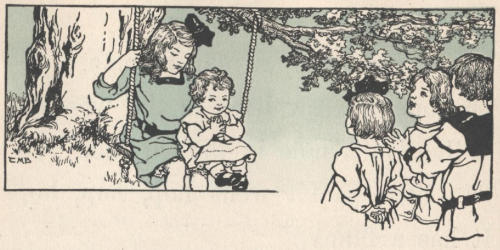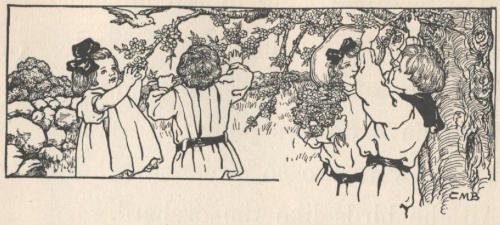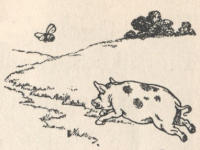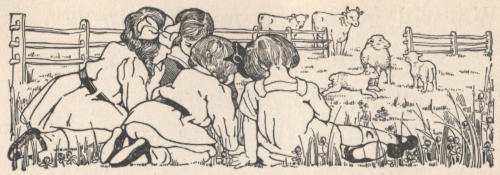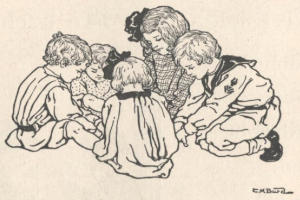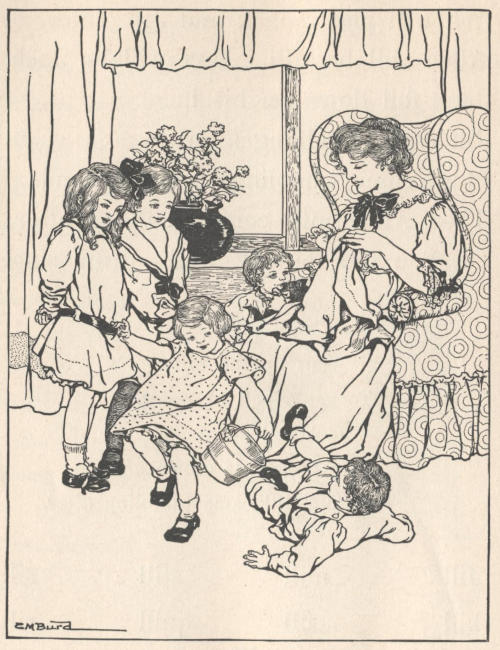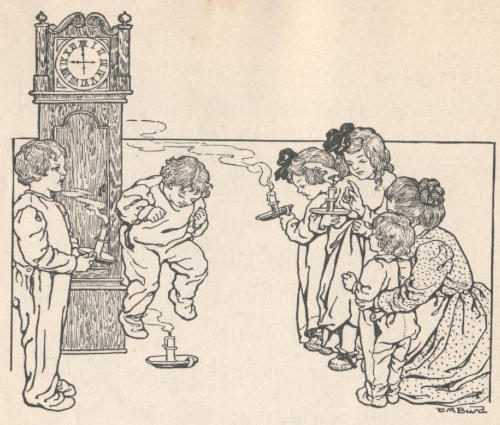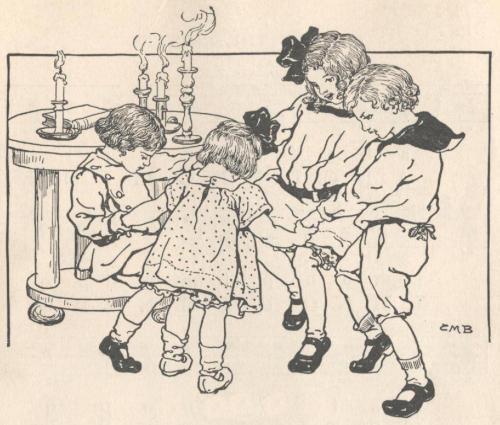The Project Gutenberg eBook of The Haliburton primer, by M. W. Haliburton
This eBook is for the use of anyone anywhere in the United States and
most other parts of the world at no cost and with almost no restrictions
whatsoever. You may copy it, give it away or re-use it under the terms
of the Project Gutenberg License included with this eBook or online
at
www.gutenberg.org. If you
are not located in the United States, you will have to check the laws of the
country where you are located before using this eBook.
Title: The Haliburton primer
Author: M. W. Haliburton
Contributor: Bruce R. Payne
Release Date: September 30, 2022 [eBook #69072]
Language: English
Produced by: Charlene Taylor, judeeylander and the Online Distributed Proofreading Team at https://www.pgdp.net (This file was produced from images generously made available by The Internet Archive)
*** START OF THE PROJECT GUTENBERG EBOOK THE HALIBURTON PRIMER ***
Transcriber’s Note: Click on the [Listen] links to hear the music.
The music files are the music transcriber’s interpretation of the
printed notation and are placed in the public domain.
THE HALIBURTON PRIMER
[i]

THE HALIBURTON PRIMER
BY
M. W. HALIBURTON
STATE NORMAL SCHOOL, FARMVILLE, VA.
D. C. HEATH & COMPANY
BOSTON NEW YORK CHICAGO
[ii]
Copyright, 1911,
By D. C. Heath & Co.
I A 6
How to teach a child to read so as to create and preserve
the right attitude toward reading is one of the most
important problems of the school. That it has not been
solved to the joint satisfaction of theorist and of practical
teacher is evidenced by the continued discussion of the
subject both in speech and in print.
This little primer may not prove to be the last word
on primary reading. It is in my opinion the most valuable
word that has yet been spoken. For here we have
several of the most important desiderata for whose combination
all are searching.
The matter is interesting to the persons to whom it is
addressed; it is a series of stories about several little children
told in conversational form. Its thought units are
short but sequential, and its vocabulary is small, each word
being presented with interest, and repeated with variety in
its relations. As a natural outgrowth of the acquaintance
with old words comes the power to decipher new words.
The phonic lessons are well graded, and the subject is[iv]
properly subordinated to thought getting. The appeal
made to the primitive, æsthetic enjoyment of the jingle,
with simple melody and captivating rhythm, as the phonics
are presented, is followed by the gratification of finding
them contributory to the ability to read the classic rimes
which follow.
That all these values characterize the book is due to
the fact that many pedagogic virtues are characteristic
of its author. Those who have seen Miss Haliburton
teach know that her power to inspire, interest, and develop
her pupils is not only due to the fleeting influence of the
much talked of “teacher’s personality,” but is largely a
transferable ability, due to a gifted woman’s sympathetic
insight into the processes of the child mind, illuminated by
the scholar’s knowledge of genetic psychology.
An intimate acquaintance with the results attained by
those whom the author has instructed in her methods,
enhances the approval which her book itself commands.
BRUCE R. PAYNE.
University of Virginia,
May 15, 1911.
[1]
Run.
Run, run.
Now stop.
Stop, stop.
[2]
See Frank.
See Alice.
See Alice run.
Run, Alice, run.
Stop, Frank, stop.
[3]
I see Alice.
I see Frank.
Do you see Alice?
Do you see Frank?
Now stop.
Stop now, Frank.
Stop, stop, Frank.
See Frank stop.
Now run.
Run, Alice.
See Alice run.
I see Alice run.
Run, Alice, run.
[4]
See the ball.
Get the ball.
Get the ball, Alice.
Run, Alice, run.
Get the ball, Frank.
Run, run, Frank.
Now get the ball.
[5]
I see Alice.
I see Alice and Frank.
Alice sees the ball.
Frank sees the ball.
Alice and Frank run.
See Alice and Frank run.
Can Alice get the ball?
Can Frank get the ball?
Frank can get the ball.
Get the ball, Alice.
You can get the ball.
Run and get the ball.
You can get the ball now.
[6]
Get the ball.
Get the ball, Frank.
Pitch the ball.
Can you pitch the ball?
I can pitch the ball.
I can pitch the ball to you.
Stop the ball, Alice.
Run and get the ball.
Now you can pitch the ball.
[7]
Frank can pitch the ball.
Frank can pitch the ball to Alice.
See Frank pitch the ball.
See Frank pitch the ball to Alice.
Can Alice pitch the ball?
Can Alice pitch the ball to Frank?
Alice said, “Pitch the ball.
Pitch the ball, Frank.
Pitch the ball to me.
Can you pitch the ball to me?”
Frank said, “I can pitch the ball.
I can pitch the ball to you.
See me pitch the ball.”
[8]
Catch the ball.
Catch it, Alice.
Can you catch it?
Pitch it to me, Frank.
I can catch it.
See me catch the ball.
See me run and catch it.
Run, Alice! Catch the ball!
[9]
Did you see Alice run?
Alice can catch a ball.
Did you see Alice catch the ball?
Frank can pitch a ball.
Did you see Frank pitch the ball?
Did you see Frank pitch it to Alice?
Frank said, “Catch the ball.
Can you catch it, Alice?”
Alice said, “Yes.
Yes, Frank, I can run and catch it.
Pitch it to me, Frank.”
Frank said, “Yes, Alice.
Run, Alice, and catch the ball.”
[10]
Bounce the ball, Frank.
Can you bounce it?
Pitch the ball to me.
I can bounce it.
I like to bounce a ball.
See me bounce it.
See me catch it.
Bounce, ball, bounce.
[11]
I saw Frank get the ball.
I saw him pitch it to Alice.
I saw Alice catch the ball.
I saw Alice run to catch it.
I saw Frank bounce the ball.
I saw Frank bounce it and catch it.
Alice said, “Bounce the ball, Frank.
Can you bounce it?
Pitch it to me, Frank.
I can bounce it.
I like to bounce a ball.”
Frank said, “See me bounce it.
Bounce, ball, bounce.”
[12]
Toss the ball, Frank.
Toss it up, up.
I can toss it up.
I like to toss a ball.
Up, up! See me toss it.
I can catch the ball.
I can run and catch it.
Can you toss it up and catch it?
[13]
Have you a ball?
I have a ball.
I saw Frank with a ball.
I saw Alice with a ball.
I saw Alice bounce the ball.
I saw Alice toss the ball.
Alice can toss it up and catch it.
Alice said, “Stop, Frank.
See me toss the ball.
I like to toss a ball.
I can toss it and catch it.
Toss the ball up, Frank.
Toss it up and catch it.”
[14]
I can kick the ball, Alice.
I like to kick a ball.
I can kick a ball high.
See me kick it high.
See me run and kick it.
Can you kick a ball, Alice?
Do you like to kick a ball?
Run and kick it, Alice.
Kick it high, Alice.
[15]
Do you play with a ball?
I like to play with a ball.
Can you kick a ball?
A boy can kick a ball.
A boy can kick a ball high.
Can you pitch a ball?
A boy can pitch a ball.
A boy can pitch a ball high.
Did you see Alice and Frank play?
I saw Alice play with a ball.
I saw Frank play with a ball.
I saw him kick the ball high.
I did not see Alice kick the ball.
Frank said, “Kick the ball high, Alice.”
[16]
Alice, I see Grace.
Grace did not see me.
I will run and hide.
Will you hide, Alice?
Run, run and hide.
Grace will catch you.
Hide, Alice, hide.
Grace will see you.
[17]
Do you play hide?
I play hide.
I like to hide.
Do you like to hide?
Frank and Alice play hide.
Grace plays with them.
Did you see Grace?
Frank saw Grace.
He said, “Alice, I see Grace.
I will run and hide.
Will you hide, Alice?
Run. Grace will see you.
Hide, Alice. Run and hide.”
[18]
Sister! Sister Grace!
Find me, Sister.
Find Frank. Find me.
Yes, I will find you.
I saw you and Frank run.
I saw you stop.
I can find you and him.
I see you now, Alice.
I have you now, Frank.
[19]
I like to play “Hide the ball.”
Do you play “Hide the ball”?
Frank and Alice play it.
Did you see them hide the ball?
I did not see them hide it.
I saw Frank and Alice run and hide.
Frank said, “Find us, Sister Grace.
Can you find us?
Find Alice. Find me, Sister.”
Did Grace find them?
Yes. She said, “I can find you.
I see you, Alice.
I see you and Frank.”
[20]
Come and jump, Alice.
Jump the rope with me.
Do you like to jump a rope?
I like to jump a rope.
I can jump high.
You can jump with me.
Come jump, Alice, jump.
[21]
Have you a rope?
Do you jump the rope?
Can you jump high?
Can you run and jump?
Grace has a rope.
Has Alice a rope?
Yes, I saw Alice with a rope.
I saw the children jumping a rope.
I saw the children run and jump the rope.
Grace said, “Come jump, Alice.
You can run and jump with me.
Can you not run and jump?
Jump, Alice, jump, jump.”
[22]
Grace, here comes Baby.
Walk with me, Baby.
She can walk, Grace.
Yes, Frank, she will walk to me.
Come here, Baby.
Come, Baby, come to me.
Walk to Sister Grace.
Walk, Baby. Walk to Grace.
Here she comes to you, Grace.
Grace has you, Baby.
[23]
Baby is Grace’s sister.
She is Frank’s sister.
She is Alice’s sister.
Have you a sister?
Is she a baby sister?
Can your baby sister walk?
Do you play with your baby sister?
I saw Baby with Frank.
I saw Baby walk to Grace.
Grace said, “Come to me, Baby.
Walk to your sister.
You can walk to me.
Walk, Baby. Walk to Sister Grace.”
[24]
Now I have you, Baby.
Come and dance.
You may dance with Baby, Frank.
Will you dance with him, Baby?
Will you dance with Alice?
Will you dance with me?
Dance with your Sister Grace.
I will dance with you.
You can dance, Baby.
Dance, Baby, dance.
Do you like to dance?
[25]
Do you like to see a baby dance?
A baby likes to jump and dance.
Can your baby sister dance?
Does she like to dance?
Do you like to dance with her?
Does she like to dance with you?
Did you see Baby dance?
No, I did not see her dance.
Did Baby dance with Grace?
No, she did not dance with Grace.
Grace said, “Come and dance, Baby.
Will you dance with me?
Dance with your Sister Grace.
You can dance, Baby.”
[26]
Baby will not dance, Grace.
She will not dance with me.
Sing for her, Grace.
Sing, and Baby will dance.
Grace will sing for us, Baby.
Sing, Grace, sing. Sing for Baby.
[27]
Can you sing?
Do you sing for your baby sister?
Does she like to hear you sing?
Will she dance for you?
Alice can sing and dance.
She sings for her baby sister.
Grace and Frank can sing too.
Did you hear Grace sing?
Did you hear her sing for Baby?
Baby likes to hear Grace sing.
Frank said, “Baby will not dance, Grace.
Sing, and she will dance.
Grace will sing for us, Baby.
Sing, Grace, and I will sing too.”
[28]
Come here, Frank.
Will you whistle for us?
Baby likes to hear you whistle.
Whistle, and she will dance for us.
Alice and I will dance with her.
Whistle for us to dance, Frank.
Yes, I will whistle, Grace.
Little sister, will you dance for me?
Now dance, little sister.
[29]
Can you whistle?
Frank can whistle and dance.
Boys like to whistle.
Frank likes to whistle for Baby.
Baby likes to hear him whistle.
Baby likes to dance for Frank.
She likes to see Frank dance.
Did you see Baby dance for Frank?
Yes, I am glad I saw her dance.
Frank said, “I will whistle.
I am glad Baby will dance for me.”
Grace said, “Whistle for Baby.
Whistle, Frank, whistle for us to dance.
Now see us dance, Frank.”
[30]
[31]
- do
- doing
- play
- playing
- sing
- singing
- jump
- jumping
- toss
- tossing
- kick
- kicking
- catch
- catching
- pitch
- pitching
- dance
- dancing
- bounce
- bouncing
- hide
- hiding
What is Grace doing?
Is she jumping a rope?
No, she is bouncing and tossing my ball.
She is singing for Baby.
Baby is jumping and dancing.
What is Frank doing? Is he hiding?
No, he is playing ball.
Is Frank kicking the ball?
No, he is pitching the ball to Alice.
[32]
Did Alice show Baby her hen?
Did she show her the little chicks?
Yes. She said, “Come with me, Baby.
Come and see my hen and chicks.
I will show you my hen.
I will show you the little chicks.
Here comes the hen, now.
She has the chicks with her.
Do you like the chicks, Baby?
I like the little chicks.”
[33]
Alice has a white hen.
The white hen has little chicks.
Are the chicks white?
No, the chicks are not white.
Grace has a black hen.
The black hen has chicks, too.
I did not see Grace’s black hen.
Baby likes the little chicks.
I saw Alice show them to Baby.
Alice said, “Come see the chicks, Baby.
I will show them to you.
I will show you my white hen.
Do you like the little chicks, Baby?”
[34]
Jet is Grace’s hen.
Jet is a black hen.
She is a mother hen.
She has little children.
Her chicks are her children.
She has a little duck with her chicks.
Grace will show the hen to Baby.
She will show her the little duck.
Grace said, “Come and see Jet’s chicks.
Mother Jet is a black hen.
Her chicks are white.
She has a baby duck with her chicks.
Mother Jet has pretty children.
The chicks and the duck are her children.
I will show you Jet’s children.”
[35]
Here is Jet with her children.
The little duck has a name.
Its name is Ducky Bet.
Do you like Ducky Bet?
I will catch Ducky Bet for you, Baby.
I will catch a chick for you, too.
Chick, chick! Come here, little chick!
[36]
Now here comes Dot.
Alice, here is your kitty.
She has come to see the chicks.
See Ducky Bet, Dot.
The little chicks run to the hen.
Do not run, little chicks.
Dot will not catch you, Ducky.
The chicks do not like you, Dot.
The little duck does not like you.
But I like my little kitty, Dot.
Come to me, you little white kitty.
[37]
Alice has a little white kitty.
Her kitty’s name is Dot.
Did you see how white Kitty Dot is?
Baby has a black kitty.
Her kitty’s name is Mink.
You will see how black Mink is.
Baby likes her black kitty.
You did not see Kitty Mink.
But you saw Alice’s white kitty.
Grace said, “Now here comes Dot.
Look, look, Alice! See the chicks run.
The chicks do not like Dot.”
Alice said, “But I like my kitty.”
[38]
Alice! Alice!
Come here, Alice.
Come see me make a sweet cake.
You can not make a cake, Grace.
Can Grace make a cake, Mother?
I will show her how to do it, Alice.
Show me, too, Mother.
I can make a sweet cake.
May I make a cake, Mother?
Yes, you and Grace may make it.
I will show you how to make it.
I am glad to have you make the cake.
[39]
Did you see Grace and Alice?
I saw Grace and Alice with mother.
Mother said, “Your cousin is coming.
I will make a cake for your cousin.
I will show Grace how to make a cake.”
Alice said, “Show me, too, Mother.
I can make a cake.
Grace and I will make it.”
Grace said, “Baby must see the cake.
Show her the cake, Alice.
Does she like sweet cake?”
Alice said, “See the cake, Baby.
It is a sweet, sweet cake.
Do you like sweet cake, Baby?
This cake is for Cousin Max.”
[40]
Look, look, Alice!
Here comes Max.
He is with Father.
Let us run and see him.
I am glad Max has come.
How do you do, Max?
I am glad to see you.
I am glad you have come.
[41]
Did you see Max?
Max is Frank’s cousin.
He is Grace’s and Alice’s cousin.
He is Baby’s cousin.
He will play with the children.
He has come to live with them.
This is Max’s home now.
I saw Frank run to Max.
Frank is glad Max has come.
Frank said, “Father has come home.
Max has come with Father.
How do you do, Max?
I am glad you are a boy.
I am glad to have a boy here.
I am glad you are to live here.”
[42]
Come with me, Max.
Come and see Mother.
Max, this is Mother.
Mother, here is Max.
He has come to live with us.
Are you not glad, Mother?
Yes, I am glad, Frank.
Come to me, Max.
How do you do, my boy?
I am glad to see you, Max.
I am glad you are to live with us.
[43]
See my drum, Alice.
Did Max give the drum to you, Frank?
Yes, and here is a doll for Baby.
This doll is for you, Baby.
See your pretty little doll.
My doll is a pretty doll, Frank.
See! Grace’s doll is a baby doll.
Did Max give us the dolls, Frank?
Yes, he did, Alice.
[44]
Frank has a drum.
Frank plays with his drum.
Did you see his drum?
Have you a drum?
Is it a big drum?
Do you play with your drum?
How do you play with it?
Grace has a big baby doll.
Alice has a big doll, too.
Baby has a little doll.
Have you a doll?
Is it a big doll?
Is it a little doll?
Do you play with your doll?
How do you play with it?
[45]
Come and play with my drum, Max.
Do you like to march?
Yes, Frank, I like to march.
Alice! Grace! Come and play.
Look, Mother, look! See us march.
Hear Frank whistle and tap his drum.
Rub-a-dub-dub! Rub-a-dub-dub!
Now Max may tap the drum.
Rub-a-dub-dub! Tap the drum, Max.
[46]
I will tap the drum. Rub-a-dub-dub!
Can you tap it like that?
Hear me tap it, Alice.
Hear it say, “Rub-a-dub-dub!”
You must tap it like that, Alice.
Now let us march.
Now we must run. Quick, quick!
Did you see Frank and Max march?
Did you see Alice and Grace march?
Max and Frank ran and ran.
Alice and Grace ran, too.
Frank said, “You must march.
You must run, too.”
Did you see them running?
[47]
Here, Lad, here, here, here!
Is Lad your dog’s name, Frank?
Yes, that is his name, Max.
Is he a big dog, Frank?
No, he is not a big dog.
I will whistle. Here he comes, Max.
Look at him. See how little he is.
Come here, Lad. Come to me.
Look at him. He will not come.
Get up and go to Max, little dog.
[48]
Will your dog catch the chicks, Frank?
No, Max, he will not catch them.
But he will play with the chicks.
He likes to play with them.
He likes to see them run.
But he must not make them run.
My dog can catch rats, Max.
I do not like to see him catch rats.
But he likes to catch them.
I like to see Lad jump.
I will show you how he can jump.
Toss the ball, and he will jump high.
I can make him jump high.
Come and see him jump, Max.
[49]
Can you find a stick, Max?
Yes, I see a stick. Here it is.
Give it to me, Max.
Can Lad jump over that stick?
Yes, he can jump over this stick.
I can make him jump over it.
Come, jump over the stick, Lad.
Jump, little dog. Jump quick!
Look, Max. Look quick!
Now you see how my dog can jump.
[50]
Is this black kitty yours, Alice?
No, that is Baby’s kitty Mink.
See how white my kitty Dot is.
She has not a spot on her.
Can Dot catch rats, Alice?
No, she is too little to catch rats.
But Dot did catch a little bat.
She saw the bat and ran to catch it.
A rat saw Dot, and ran.
Did Dot catch the rat, Alice?
No, but she saw it jump and run.
Then I saw it run and hide.
[51]
PHONIC JINGLES
To be read by teacher and sung by pupils.
|
|
Phonic Drill |
|
|
1. The Kitty-cat |
cat |
| Sat on a mat. |
mat |
| She saw a bat. |
bat |
| She said, “What’s that? |
that |
| Ah, that’s a rat! |
rat |
| Pit-pitty-pat!” |
pat |
|
|
2. The little rat, |
rat |
| So sleek and fat, |
fat |
| Who quiet sat |
sat |
| Behind a hat, |
hat |
| Ran “Pitty-pat” |
pat |
| From Kitty-cat. |
cat |
M. S. Willis.
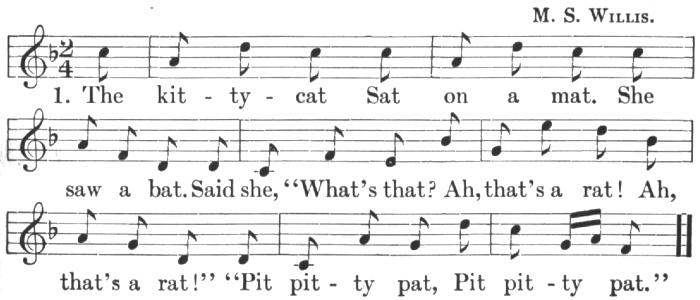
[Listen]
1. The kit-ty-cat Sat on a mat. She
saw a bat. Said she, “What’s that? Ah, that’s a rat! Ah,
that’s a rat!” “Pit pit-ty pat, Pit pit-ty pat.”
[52]
I like rabbits, Max.
I have a white rabbit.
His name is Bun.
Come and see my rabbit, Max.
See how white he is.
Bun has not a spot on him.
Do rabbits like apples, Frank?
Yes, I will give Bun an apple.
Bun, Bun, Bun! Here is an apple.
Apples! Apples! See the apples, Bun.
[53]
Jump, Bun. Jump for the apple.
He will not jump for the apple.
Can you catch him, Frank?
Yes, you can catch him, too, Max.
I will give him an apple, Frank.
Then I will catch him.
Now I have him, Frank.
How white he is!
My rabbit runs away, Max.
I can not keep him at home.
I will make a pen for him.
Then we can keep him here.
Can you make a pen, Frank?
Yes, I can make a pen for Bun.
[54]
What is that, Frank?
This is a pen for Bun, Alice.
You see he runs away.
Now I can keep him in this pen.
Yes, you can, Frank.
Make a little bed for Dot, Frank.
You and Max can make it.
Yes, I will make the bed, Alice.
Will Dot sleep in a bed, Alice?
Yes, she will sleep in a doll bed.
I will make her sleep in it.
[55]
Oh, kitty, kitty, what a black spot!
Where did you get this spot, kitty?
How did you get it?
See this black spot on Dot, Baby.
Alice can not keep her white.
Did you see Dot’s little bed, Baby?
She has a little bed now.
Here is the little bed.
Dot will sleep in the little bed.
Alice will make her sleep in it.
Come, get into your bed now, Dot.
[56]
Frank said, “Bun runs away.
We will make a pen for him, Max.”
Did you see Frank and Max catch Bun?
They can keep Bun in the pen now.
Did you see the little bed for Dot?
Did you see Frank and Max make it?
They can make little beds.
Frank said, “Will Dot sleep in a bed?”
Alice said, “Yes, she will sleep in it.
I will make her sleep in a doll bed.”
Grace saw a black spot on Dot.
She said, “Look at this black spot!
Where did you get this spot, kitty?
Alice can not keep you white.
Come and get into your bed, Dot.”
[57]
PHONIC JINGLES
|
|
Phonic Drill |
|
|
1. Oh, dear me, Dot, |
Dot |
| Is this not |
not |
| A black spot |
spot |
| You have got? |
got |
| Tell me, Dot. |
Dot |
|
|
2. I love you, Dot. |
Dot |
| Do I not, |
not |
| Little tot? |
tot |
| Here’s your cot. |
cot |
| Good-by, Dot. |
Dot |
M. S. Willis.

[Listen]
1. Oh, dear me! Dot, Is this not A black
spot you have got? Tell me, Dot, tell me, Dot.
[58]
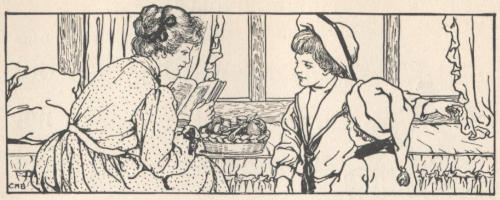
Mother, may we go with Father?
Where is your father going, Frank?
He is going to town, Mother.
May Max and I go with Father?
Yes, you and Max may go.
May Grace and Alice go, Mother?
Yes, they may go with you.
Where is Baby, Mother?
Let Baby go with us, Mother.
Oh no, Frank, I can not let her go.
I will keep Baby here with me.
[59]
Where are you going, Frank?
I am going to the barn, Max.
Come and go with me.
We will get the horses for Father.
Father is going to town.
Mother says we may go with him.
Oh, I am glad we are going, Frank.
Are Grace and Alice going with us?
Yes, Mother says they may go, too.
Is Baby going, Frank?
No, Mother will not let Baby go.
She will keep Baby with her.
Now let us run to the barn.
Let us catch the horses for Father.
I catch a horse with an apple.
[60]
Max, come look at the red oxen.
Oh, how big the red oxen are!
See how they can pull.
Oxen can pull like horses.
Can the oxen run, Frank?
Yes, Max, oxen can run.
But oxen do not like to run.
They like to walk.
I do not like to drive oxen.
I like to drive horses.
Father will show you how to drive, Max.
He will let you drive the horses.
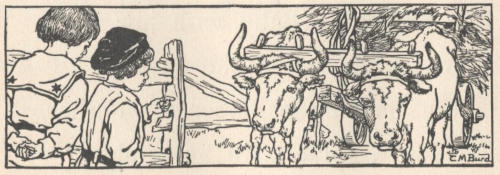
[61]
Did you see the children?
They were going through the woods.
They like the pretty woods.
The boys like to drive the horses.
Frank’s father has big horses.
Did you see the big horses?
Do you know how to drive?
Father lets Frank drive the horses.
He lets Max drive the horses, too.
Father knows how to drive the oxen.
Frank said, “Look at the big, red oxen.
Oxen can pull like horses.
But they can not run like horses.”
[62]
Father said, “Do you hear the birds?
Do you hear them sing, Max?
Look for them, as we drive.
Tell me where you see them.
Tell me what you see them doing.
Tell me how they look.
Look up in the trees, Max.
The birds are over us in the trees.”
“You must know the birds, Max.
You must know how they look.
You must know how they sing.
I hear a bird now, children.
Do you know what bird it is?
Do you hear it, Frank?
It is not singing. What is it doing?”
[63]
I see the bird up in an apple tree.
Do you see it?
How pretty it is!
Its head is red.
It taps on the tree.
Do you hear it?
“Tap! tap! tap!”
I see the bird with the red head.
There is sap in the tree.
The bird likes the sap in the tree.
It is getting the sap now.
It taps on the tree.
It does this to get the sap.
How does the bird get the sap?
It makes a little hole in the tree, Max.
[64]
M. S. Willis.
Lively.

[Listen]
Ho! Red-cap! Lit-tle chap, Go “Tip-tap” With a rap;
Make a gap, Sip the sap, Fly “flip-flap.”
PHONIC JINGLES
|
|
Phonic Drill |
|
|
Ho! Red-cap! |
cap |
| Little chap, |
chap |
| Go “Tip-tap” |
tap |
| With a rap. |
rap |
| Make a gap, |
gap |
| Sip the sap, |
sap |
| Fly “flip-flap.” |
flap |
- flip
- slip
- tip
- rip
- trip
- skip
[65]
We are going to school, Max.
I am glad you are going with us.
I like to go to school.
I like to write in school. Do you?
Yes, I like to write, Frank.
Is your school in town?
No, we do not go to school in town.
This is the way we go to school.
You see we go through the woods.
We see the birds on the way to school.
We hear the birds sing.
We find the birds’ nests.
We look at the nests.
I will show you the birds’ nests.
Then we will go away.
[66]
Come, Alice. Come, Grace.
We are going home now, Max.
Which way are you going, Frank?
We did not come this way.
We came another way, Max.
That way was through the woods.
Did you like the school, Max?
Yes, Frank, I like your school.
I do not like to go to school in town.
I like to go to this school.
[67]
I see another bird.
Here it comes.
It comes, hop, hop.
See how it hops.
What a little bird!
Its head is not red.
Its head is black.
I hear it saying, “Quit, quit!”
Now it is singing, “Chick-a-dee-dee!”
It is the chickadee you hear singing.
I see the chickadee now, Max.
The chickadee has another name.
Tomtit is another name for chickadee.
Tomtit is saying, “Quit, quit.”
What are they doing to you, Tomtit?
[68]
PHONIC JINGLES
|
Phonic Drill |
| 1. I wonder who hit |
hit |
| That little Tomtit. |
Tom tit |
| He said, “Quit, quit, quit!” |
quit |
| 2. Why do you not sit |
sit |
| Where you are, Tomtit? |
Tom tit |
| You wee, saucy chit! |
chit |
| 3. And now that you’ve lit, |
lit |
| Tomtit, do not flit, |
flit |
| But sing us a bit. |
bit |
M. S. Willis.
Lively.

[Listen]
4. “Twit-twit-ter! Twit-twit!” Sang lit-tle
Tom-tit. Then, “Chick-a-dee-dee!”
[69]
I see Father at the barn.
He has the horses.
The horses are glad to be at home.
The horses and cows live at the barn.
It is home for them.
The pigs sleep here, too, Max.
We keep the little pigs in a pen.
Come this way and see the pigs.
Alice has a greedy, greedy little pig.
I have a pig too.
[70]
Here is Piggie Wee.
Here is Piggie Wig.
Piggie Wee is Alice’s pig.
Piggie Wig is my pig.
Which is Piggie Wee?
Which is Piggie Wig?
Can you tell, Frank?
Yes, I can tell.
I can tell which is Piggie Wig.
I can tell which is Piggie Wee.
Piggie Wig has a curly tail.
Look at his curly tail, Max.
But Piggie Wee’s tail is not curly.
See how Piggie Wig jumps and dances.
Greedy Piggie Wee goes to bed.
[71]
I know the pigs now, Frank.
Your pig has the funny, curly tail.
Alice’s greedy pig says, “Wee! Wee!”
I like your little, greedy pig, Alice.
I like your pig, too, Frank.
I like its curly tail.
I know a funny rime, Max.
It is about little Piggie Wig.
Grace and I write rimes, Max.
We write funny rimes at school.
Mother writes rimes for Alice.
Father writes funny rimes for her.
Father writes funny rimes for us, too.
[72]
PHONIC JINGLES
|
|
Phonic Drill |
|
|
1. I saw a little pig |
pig |
| In a curly wig, |
wig |
| A-dancing a jig. |
jig |
| ’Twas little Piggie Wig. |
Wig |
| Jolly little pig! |
pig |
|
|
2. Dressed in this funny rig, |
rig |
| He rode in a gig, |
gig |
| Till he grew so big, |
big |
| He had to root and dig. |
dig |
| Hungry little pig! |
pig |
M. S. Willis.
Spirited.

[Listen]
1. I saw a lit-tle pig In a cur-ly wig, A-danc-ing a
jig; ’Twas lit-tle Pig-gie-wig, Jol-ly lit-tle pig!’Twas
lit-tle Pig-gie-wig, Jol-ly lit-tle pig!
[73]
Let us go to the pond, Max.
Where is the pond, Frank?
It is over in the woods.
It is a pretty pond.
It is away under the big trees.
Where are Alice and Grace, Frank?
Will they go with us?
Yes, they will go to the pond.
Alice goes to the pond for violets.
We find violets there in the woods.
We get violets for Mother.
Alice! We are going after violets.
Come and go with us.
We are going over to the pond.
Let Lad come with you, Alice.
[74]
What a pretty day it is, Grace!
And what a pretty pond this is!
Look at the ducks in the water!
See that big duck with the curly tail!
Yes, they are here all day in the water.
They make nests here at the pond.
Do all the ducks lay here, Grace?
No, I have ducks at the barn.
They lay at the barn.
That is where they live.
[75]
A big brook runs into this pond.
The brook runs through the woods.
The violets bloom at the brook.
They bloom under the big trees.
The cows come to the brook.
The sheep and lambs come too.
They like the water in the brook.
Do you see where Alice is?
She is going away up the brook.
She finds the violets that bloom there.
She finds the violets under the big trees.
Can you hear what Alice says to us?
She says, “Violets! Violets!
Come see the violets!”
[76]
Look at the ducks in the woods.
They are the ducks that live at the barn.
I see my black hen with them.
She has all of her children.
The duck and chicks are Jet’s children.
Don’t you see them running about?
That little duck’s name is Ducky Bet.
Let us go where they are, Max.
How came you here, Mother Jet?
Where are your children going?
[77]
The ducks are going to the pond.
Jet does not know where they are going.
Ducky Bet knows where they are going.
The ducks will get into the water.
Ducky Bet may go into the water, too.
She is running after the other ducks.
Let us go back to the pond, Max.
Alice! Alice! Come and look at Jet!
She is running after Ducky Bet.
Bet is running after the other ducks.
Jet says, “Cluck, cluck, cluck!
Come back, baby duck, duck, duck!”
The other ducks say, “Quack, quack!
Ducky Bet, go back, back, back!”
There! Ducky Bet is in the water.
[78]
PHONIC JINGLES
|
|
Phonic Drill |
|
|
1. “It’s not sunset,” |
set |
| Said Ducky Bet |
Bet |
| To Mother Jet. |
Jet |
| “These ducks I’ve met, |
met |
| I can not let |
let |
| Them leave me yet.” |
yet |
|
|
2. Then Mother Jet |
Jet |
| Began to fret. |
fret |
| “My little pet,” |
pet |
| She said to Bet, |
Bet |
| “You must not get |
get |
| Your feathers wet.” |
wet |
M. S. Willis.

[Listen]
1. “It’s not sun-set,” said Duck-y Bet to Moth-er Jet.
“These ducks I’ve met, I can-not let Them leave me yet.”
[79]
[80]
I will tell Frank to get the little duck.
Frank! Come here to the pond.
Come quick and get Ducky Bet.
There! Frank has caught the ducky.
Give the ducky to her mother, Frank.
Mother Jet, here is your baby duck.
Go to the barn with your children.
That is where you live. Shoo! Shoo!
Frank came and caught the ducky.
The hen saw him after her baby duck.
She ran about and said, “Cluck, cluck!”
The chicks said, “Peep, peep!”
The ducks said, “Quack, quack!”
Frank said, “Shoo! Shoo! Shoo!”
Lad ran about and said, “Bow-wow!”
[81]
What are you looking for, Frank?
I am looking for frog’s eggs, Max.
The frogs lay eggs in the water.
Oh, do find some of the frog’s eggs!
Find some, and let me see them.
Do frogs lay eggs in nests, Frank?
O Max! Frogs don’t make nests.
Don’t you know that? How funny!
I will show you some frog’s eggs.
I can find them in the pond.
Here are some of them now.
Come and look at the eggs, Max.
Eggs? Well! They are funny eggs!
They are not at all like bird’s eggs.
[82]
Come quick, Max. Look quick!
See that little frog.
Don’t you see it?
Watch! It will jump.
Come here, Lad.
Don’t go there.
Pull him back, Max.
See the frog jump into the water.
The boys saw a frog in the brook.
Frank said, “Don’t go there, little dog.
You must not go after the frog, Lad.
Come back, little dog. Come, Lad.”
Lad said, “Bow-wow, Bow-wow!”
This made the frog jump back.
It went “Ker-chog!” into the water.
[83]
PHONIC JINGLES
|
Phonic Drill |
| 1. A little frog |
frog |
| Sat on a log, |
log |
| In a thick fog, |
fog |
| Beside the bog. |
bog |
| 2. A little dog |
dog |
| Came to the log. |
log |
| Frog went “Kerchog!” |
Ker chog |
| Into the bog. |
bog |
M. S. Willis.
Slowly.

[Listen]
1. A lit-tle frog Sat on a
log, In a thick fog, Be-side the bog.
[84]
Will the frog come up again, Frank?
Yes, he came up then.
He has his head out now.
Don’t you see his head in the water?
Look! He went under the water.
Now he has come up again.
He is looking at us. Let us hide.
There! Did you see him jump?
He is out of the brook now?
It is time to go home, Max.
Oh no, please don’t go, Grace.
Yes, we must go, Max.
Let us all go through the woods.
We will go to the barn and play.
Yes, Grace, please go to the barn.
[85]
Look at that rabbit.
Where, Frank, where?
Please show me.
Look in the woods.
Oh, I see him now.
Look at him hop.
See his little white tail!
There he goes! See him jump!
That Rabbit is not like Bun, Frank.
No, Max, that rabbit is Bun’s cousin.
Bun’s cousins live here in the woods.
They have homes in the woods.
What is a rabbit’s home like, Frank?
It is a hole under the ground, Max.
Rabbits make the hole in the ground.
[86]
One time I saw a rabbit’s home.
I went with Father to see it.
The hole was away under the ground.
The mother rabbit was not in the hole.
The baby rabbits were sleeping there.
Father said, “Pull them out, Frank.
Now look at them.
Then let them go back into the hole.”
Please show me a rabbit’s home, Frank.
Yes, some day I will be glad to, Max.
Thank you, Frank, thank you.
I like to see a rabbit jump. Don’t you?
Yes. I know a rime about a rabbit.
It is a rime that I can sing.
Please sing it for me, Frank.
[87]
PHONIC JINGLES
|
|
Phonic Drill |
|
|
1. Wild little Bun, |
Bun |
| Sit in the sun, |
sun |
| Then run, run, |
run |
| That is fun. |
fun |
|
|
2. There you go “Thump!” |
Thump |
| Over the stump, |
stump |
| With a bump, |
bump |
| As you jump. |
jump |
| |
|
| |
|
|
|
3. A home you’ve dug. |
dug |
| There you’re as snug |
snug |
| As a bug |
bug |
| In a rug. |
rug |
M. S. Willis.
Lively.

[Listen]
1. Wild lit-tle Bun, Sit in the
sun; Then run, run, That is fun.
[88]
Look, Frank! What bird is that?
That is a bat, Max.
It can fly, Frank.
Yes, a bat can fly.
It can fly like a bird.
A bat can fly as high as a bird, too.
There it goes. Up, up, it goes.
Can you catch the bat, Frank?
Yes, I will catch it with my hat.
Here it is. I caught it with my hat.
It looks like a rat, Frank.
No, it looks like a mouse, Max.
We will show the bat to Father.
Then we will let it fly away again.
[89]
Did you see Frank run after the bat?
I saw him catch it.
The bat was flying when he caught it.
Frank caught the bat under his hat.
He ran after it and said,
“Bat, bat,
Come under my hat.
And when I bake,
I will give you a cake.”
[90]

We will run up on the hay.
Then we will jump down again.
Alice, we will pull you up on the hay.
Thank you. Now I will jump down.
Jump down. Jump this way, Grace.
It is your time to jump again, Alice.
Max, look over your head.
What is that? What is that, Frank?
Look out, Max! Run, run, Max!
[91]
Do you know what made Max run?
An owl came out of the barn.
It flew down at Max and made him run.
It flew at his head.
Max did not know what it was.
He said, “What is that?”
Then he ran down on the hay.
Frank said, “Look out, Max. Run!”
The owl flew back up on the hay.
Then Frank ran up on the hay.
He caught the owl under his hat.
That was the way he caught the bat.
Grace said, “Let me see the owl, Frank.
Do you know what an owl looks like?
Yes, it looks like a cat.”
[92]
Frank said, “Come back, Max.
It is an owl. Come and see it.”
Max went back to look at the owl.
He said, “How that owl made me run!
He does look like a cat, Grace.
I know a rime about an owl.
It is about an owl making a boy run.
It is not about me and this owl.
It is about another owl and another boy.
I will say the rime for you.”
“A little boy went into a barn
And lay down on some hay;
An owl came out and flew about
And the little boy ran away.”
[93]
What are you doing, Baby?
Are you watching the kitty cat?
Dot is watching a little fly.
Can you catch the fly, Dot?
Look at little black Mink, sleeping.
Mink will not catch the fly.
Mink is not quick. Dot, be quick.
Run to the window, Dot.
Catch the fly when it comes.
Catch it, Mink! Catch it, Dot!
Catch it, Baby!
[94]
M. S. Willis.
With animation.

[Listen]
1. Ba-by-bye, Here’s a fly. We will watch him, You and I.
PHONIC JINGLES
|
Phonic Drill |
| 2. My, my, my! |
my |
| He is shy. |
shy |
| That is why |
why |
| He will fly. |
fly |
| 3. He is sly. |
sly |
| You he’ll spy. |
spy |
| He is spry. |
spry |
| Catch him! Try! |
try |
| 4. See him fly |
fly |
| Toward the sky. |
sky |
| Say, “Good-by, |
by |
| Little fly!” |
fly |
[95]
Come to the window again, Baby.
Look out through the window.
Watch the little chickadee on the ground.
Stop, little bird! Come to the window.
Baby, did you see how he shook his tail?
He shook it and shook it and flew away.
I saw a little bird
Come, hop, hop, hop.
So I said, “Little bird,
Will you stop, stop, stop?”
And was going to the window
To say, “How do you do?”
But he shook his little tail
And then away he flew.
[96]
Baby, Frank caught an owl.
We have a little bat, too, Baby.
The owl was in the barn.
It made Max run. It flew at his head.
It was funny to see Max run.
Frank will show you the owl.
Frank, where are the owl and the bat?
Please show them to Mother and Baby.
Mother, look at the owl.
Look at this bat. It is a little one.
We will show them to Father.
He knows where there is an owl’s nest.
It makes a bed in a hole in a tree.
Baby, look at the little bat.
It looks like a mouse.
[97]
Bun has some rabbit cousins.
We saw one as we came home.
The one we saw lives in the woods.
It lives in a hole in the ground.
The little rabbit went hop, hop, hop.
It has a funny, little, white tail.
It did not look much like Bun.
We saw Mother Jet and her children.
We saw all of the other ducks.
Ducky Bet was with the other ducks.
Mother Jet said, “Cluck, cluck, cluck!
Come back, Baby duck, duck, duck!”
[98]
It is so pretty to-day.
Let us go out and swing Baby.
Grace, you may swing with Baby.
Come, Frank. Let us swing them.
Pull, Frank. Pull the swing back.
Now let it go again, Frank.
You may run under the swing, Max.
Don’t you hear the birds singing?
They say, “Sweet! Sweet! Sweet!”
Look up over your head at the birds.
Sing, Baby! Sing, Alice! Sing, boys!
[99]
M. S. Willis.

[Listen]
1. Ba-by, swing, Dear lit-tle thing! Hap-py as a king.
PHONIC JINGLES
|
Phonic Drill |
| 1. Baby, swing, |
swing |
| Dear little thing! |
thing |
| Happy as a king. |
king |
| 2. Birdies, sing. |
sing |
| Sing on the wing. |
wing |
| Sweetest music bring. |
bring |
| 3. It is spring. |
spring |
| Flower bells, ring. |
ring |
| Wide your fragrance fling. |
fling |
| 4. “Spring, sweet spring!” |
spring |
| The children sing, |
sing |
| “It is lovely spring.” |
spring |
[100]
Father, we caught a bat and an owl.
We caught them as we came home.
Grace says the owl looks like a cat.
The owl does look much like a cat.
Max says the bat looks like a rat.
I say it looks like a mouse.
Which does it look like, Father?
It looks very much like a mouse.
It looks like a rat too, Frank.
Father, tell about the owl and the bat.
Tell about Mr. Owl and Mrs. Bat.
[101]
An owl said to a bat,
“Do you know the rat, Mrs. Bat?”
“No, I do not, Mr. Owl,” said the bat.
“Well, you look very much like the rat, Mrs. Bat.”
“Can the rat fly, Mr. Owl?”
“Oh no, a rat can not fly, Mrs. Bat.”
“But, you see, Mr. Owl, I can fly.”
“Do you know the cat, Mr. Owl?” said the bat.
“No, I do not, Mrs. Bat,” said the owl.
“Well, you look very much like the cat, Mr. Owl.”
“Can the cat fly, Mrs. Bat?”
“Oh no, a cat can not fly, Mr. Owl.”
“But you see, Mrs. Bat, I can fly.”
[102]
Said the owl to the bat,
“What is that?”
“That’s the cat,” said the bat.
Said the owl to the bat,
“Do I look like that cat?”
“You do,” said the bat.
“Mr. Owl,” said the bat,
“What is that?”
“That’s the rat, Mrs. Bat.”
“Mr. Owl,” said the bat,
“Do I look like that rat?”
“You do, Mrs. Bat.”
[103]
Max, we are going to the orchard.
I know you will like the orchard.
The apple trees are so pretty.
They have flowers now.
The flowers are so sweet, too.
All the birds like the orchard.
I saw a nest there one day.
There were some little eggs in it.
Was it a chickadee’s nest, Alice?
No, it was not a chickadee’s nest.
I saw the bird fly to the nest.
I did not know what bird it was.
Here is the orchard, Max.
Let us get some flowers.
The apple trees have pretty flowers.
The apple flowers are red and white.
[104]
Oh, how pretty the apple trees are!
Look at the bees on the flowers.
Do you know what the bees say?
Down in the flower,
Hear me, the bee,
Going, “Zee, zee, z-ee!”
Out of the flower,
I come. Hear me hum,
Going, “Zum, zum, z-um!”
[105]
The pigs like to come to the orchard.
They like the orchard as much as we do.
They come when there are apples here.
We saw all the pigs here one day.
We made a rime about Piggie Wee.
Tell about Piggie Wee and the bee.
You know how greedy Piggie Wee is.
One day he was in the orchard.
He saw an apple on the ground.
But there was a bee on the apple.
So the greedy pig ran after the bee.
Then the bee flew at Piggie Wee.
The bee made Piggie Wee run.
It flew after him and said, “Zee, zee!”
Piggie ran and said, “Wee, wee, wee!”
[106]
PHONIC JINGLES
|
|
Phonic Drill |
|
|
1. Piggie-Wee |
|
| Saw a bee. |
|
| “See! See! See! |
|
| Here’s a bee |
bee |
| Under the tree. |
tree |
| I’ll get that bee,” |
bee |
| Said Piggie-Wee. |
Wee |
|
|
2. Then the bee |
bee |
| Said in glee, |
glee |
| “Zee! Zee! Zee! |
Zee |
| Piggie-Wee!” |
Wee |
| This made him flee, |
flee |
| And, “Wee! Wee! Wee!” |
Wee |
| Cried Piggie-Wee. |
Wee |
M. S. Willis.

[Listen]
1. Pig-gie-wee Saw a bee. “See! See! See! Here’s a
bee Un-der the tree.” “I’ll get that bee,” said Pig-gie-wee.
[107]
We will go to the meadow to-day.
We will drive the cows to the meadow.
They all like to go there.
The sheep like the meadow, too.
They will be in the meadow to-day.
The meadow clover has its flowers.
I like to see the clover blooms.
They are sweet, red clover balls.
The bees are in the meadow all day.
They hum over the clover.
They like the sweet clover blooms.
Some of the clover blooms are white.
Some of them are as red as red can be.
I like to see the bees on the clover.
Let us run to the meadow.
[108]
Hear the bees hum, Max.
They go “Zum, zum,” as they hum.
Get down on the ground to see them.
Yes, I see them, Alice.
But I like to watch the lambs.
Watch that little lamb run and play.
Yes, that is my lamb, Max.
The other lamb is Frank’s.
Look at Bossy. Bossy is Grace’s cow.
Bossy has a little bell. Do you see it?
I like to hear Bossy’s bell.
[109]
It is time to drive the cows home.
Boys, please find the cows.
I don’t see Bossy. But I hear her bell.
Don’t you hear Bossy’s bell?
Yes, I hear it, Grace.
Bossy’s bell goes “Tinkle, tinkle, tinkle!”
I like to hear Bossy’s little bell.
We will go over the hill to the brook.
Bossy knows where to find water.
She knows where to find the big trees.
There! I see Bossy in the brook.
Let me drive her out, Frank.
I will go into the brook.
Very well, Max. Drive her out.
[110]
M. S. Willis.

[Listen]
1. Tin-kle, tin-kle, tin-kle, Bos-sy’s lit-tle bell.
Tin-kle, tin-kle, tin-kle, Bos-sy likes it well.
[111]
PHONIC JINGLES
|
Phonic Drill |
| 1. Tinkle, tinkle, tinkle! |
|
| Bossy’s little bell. |
bell |
| Tinkle, tinkle, tinkle! |
|
| Bossy likes it well. |
well |
| 2. Tinkle, tinkle, tinkle! |
|
| Where she is ’twill tell. |
tell |
| Tinkle, tinkle, tinkle, |
|
| In the shady dell. |
dell |
| 3. Tinkle, tinkle, tinkle, |
|
| Where the green grass grows, |
grows |
| Tinkle, tinkle, tinkle, |
|
| Where sweet water flows, |
flows |
| 4. Tinkle, tinkle, tinkle, |
|
| Where the soft wind blows, |
blows |
| Tinkle, tinkle, tinkle, |
|
| All this Bossy knows. |
knows |
[112]
Play “Two Little Black Birds,” Baby.
I will show you the birds.
Here are two black birds on a hill.
One is Jack. The other is Jill.
The two black birds will fly away.
Then they will come again.
Two little black birds
Sat upon a hill.
One was Jack.
The other was Jill.
Fly away, Jack!
Fly away, Jill!
Come back, Jack!
Come back, Jill!
[113]
Let us play “Hickory, dickory, dock.”
O Alice, Baby can not run!
Can she play that she is the mouse?
No, but she can watch us run.
Hickory, dickory, dock,
The mouse ran up the clock.
The clock struck one.
The mouse ran down.
Hickory, dickory, dock!
[114]
Watch us play “Pease-pudding.”
When is the pease-pudding in the pot?
When is it hot? When is it cold?
When is the pease-pudding old?
Max and I keep time like a clock.
Pease-pudding hot,
Pease-pudding cold,
Pease-pudding in the pot,
Nine days old.
Some like it hot.
Some like it cold.
Some like it in the pot,
Nine days old.
[115]
We will play “Jack and Jill” now.
Alice will be Jill. Max will be Jack.
Jack fell down on his head.
Jill came tumbling after.
Max, come tumbling to the ground.
Then Alice must come tumbling after.
Oh you did it very well. Now sing.
Jack and Jill
Went up the hill
To get a pail of water.
Jack fell down
And broke his crown,
And Jill came tumbling after.
[116]
[117]
The children are playing “Jack and Jill.”
Alice says, “I must have a pail, Grace.”
Grace says, “Frank will get a pail.
Thank you. Here is the pail, Alice.
Mother says she will sing with us.”
“Thank you, Mother. Thank you.”
Jack, come tumbling down.
Now, Jill, you must come tumbling down.
Frank says, “Sing some other song.
Let us sing about the cunning mouse.
Mink is black all over. Baby loves her.
Do you love Mink very much, Baby?
Well, we will sing a song, Baby.
We will sing about your kitty.”
[118]
“I’LL SING A SONG”
Ding-dong, ding-dong!
I’ll sing you a song.
It’s not very long.
It’s about a little mouse.
He looked very cunning
As I saw him running
About my father’s house.
Ding-dong, ding-dong!
I’ll sing you a song.
It’s not very long.
It’s about a little kitty.
She is black all over,
And I know you’ll love her,
For she is very pretty.
[119]
M. S. Willis.
With animation.

[Listen]
1. We’ve a lit-tle kit-ty, Just as black as ink;
She is ver-y pret-ty, And her name is Mink.
PHONIC JINGLES
|
Phonic Drill |
| 1. We’ve a little kitty |
|
| Just as black as ink. |
ink |
| She is very pretty, |
|
| And her name is Mink. |
Mink |
| 2. She’s a silly kitty, |
|
| See her sit and blink! |
blink |
| Isn’t it a pity |
|
| She knows how to wink? |
wink |
| 3. She’s a lazy kitty |
|
| Till there’s milk to drink. |
drink |
| Then she is so busy |
|
| She’s no time to think. |
think |
[120]
Jack, be nimble! Jack, be quick!
Jack, jump over the candlestick!
Don’t kick the candle over, Max.
The clock has struck bedtime.
Good night, children.
[121]
A SONG
Merry have we met
And merry have we been.
Merry let us part
And merry meet again.
With a merry ding-dong
Happy, gay, and free,
With a merry sing-song,
Again we’ll happy be.
[122]
SONG OF THE LETTERS
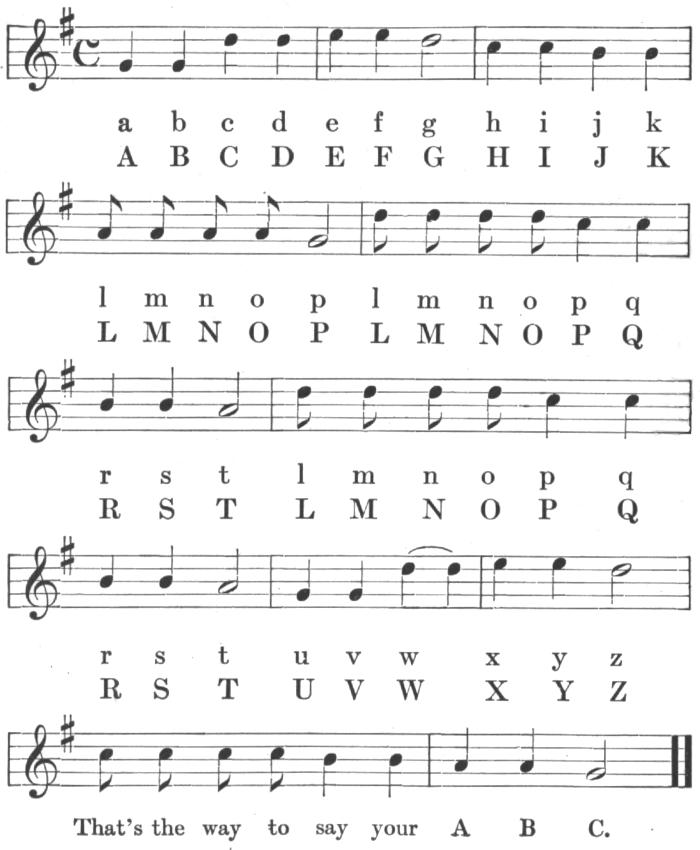
[Listen]
a b c d e f g h i j k
A B C D E F G H I J K
l m n o p l m n o p q
L M N O P L M N O P Q
r s t l m n o p q
R S T L M N O P Q
r s t u v w x y z
R S T U V W X Y Z
That’s the way to say your A B C.
| 1. |
run |
|
now |
|
stop |
| 2. |
see |
|
Frank |
|
Alice |
| 3. |
do |
|
you |
|
I |
| 4. |
the |
|
ball |
|
get |
| 5. |
and |
|
can |
| 6. |
pitch |
|
to |
| 7. |
said |
|
me |
| 8. |
catch |
|
it |
| 9. |
did |
|
a |
|
yes |
| 10. |
bounce |
|
like |
| 11. |
saw |
|
him |
| 12. |
toss |
|
up |
| 13. |
have |
|
with |
| 14. |
kick |
|
high |
| 15. |
play |
|
boy |
|
not |
| 16. |
Grace |
|
will |
|
hide |
| 17. |
them |
|
he |
| 18. |
sister |
|
find |
| 19. |
us |
|
she |
| 20. |
come |
|
jump |
|
rope |
| 21. |
has |
|
children |
| 22. |
here |
|
walk |
|
baby |
| 23. |
is |
|
your |
| 24. |
dance |
|
may[124] |
| 25. |
does |
|
no |
|
her |
| 26. |
sing |
|
for |
| 27. |
hear |
|
too |
| 28. |
whistle |
|
little |
| 29. |
am |
|
glad |
| 31. |
what |
|
my |
| 32. |
show |
|
hen |
|
chicks |
| 33. |
white |
|
are |
|
black |
| 34. |
Jet |
|
mother |
|
duck |
|
pretty |
| 35. |
name |
|
Ducky |
|
Bet |
| 36. |
Dot |
|
kitty |
|
but |
| 37. |
how |
|
look |
|
Mink |
| 38. |
make |
|
sweet |
|
cake |
| 39. |
cousin |
|
Max |
|
must |
| 40. |
Father |
|
let |
| 41. |
live |
|
this |
|
home |
| 43. |
drum |
|
doll |
|
give |
| 44. |
his |
|
big |
| 45. |
march |
|
tap |
|
rub-a-dub |
| 46. |
quick |
|
ran |
|
that |
|
say |
| 47. |
Lad |
|
dog |
|
at |
|
go |
| 48. |
rats |
| 49. |
stick |
|
over |
| 50. |
spot |
|
on |
|
bat |
|
then |
| 52. |
rabbit |
|
Bun |
|
apples |
|
an |
| 53. |
away |
|
keep |
|
pen[125] |
| 54. |
bed |
|
sleep |
|
in |
| 55. |
where |
|
oh |
|
into |
| 56. |
they |
|
we |
| 58. |
town |
| 59. |
barn |
|
horses |
|
says |
| 60. |
red |
|
pull |
|
oxen |
|
drive |
| 61. |
through |
|
woods |
|
know |
|
were |
| 62. |
tell |
|
trees |
|
birds |
|
as |
| 63. |
head |
|
there |
|
sap |
|
hole |
| 65. |
school |
|
write |
|
way |
|
nests |
| 66. |
which |
|
came |
|
another |
| 67. |
hop |
|
quit |
|
chickadee |
|
tomtit |
| 69. |
cows |
|
pigs |
|
greedy |
|
be |
| 70. |
Piggie Wee |
|
Piggie Wig |
|
curly |
|
tail |
|
goes |
| 71. |
funny |
|
rimes |
|
about |
| 73. |
pond |
|
under |
|
violets |
|
after |
| 74. |
day |
|
water |
|
lay |
|
all |
| 75. |
bloom |
|
brook |
|
sheep |
|
lambs |
| 76. |
don’t |
|
of |
| 77. |
other |
|
back |
|
cluck |
|
quack |
| 80. |
caught |
|
shoo |
|
peep |
|
bow-wow[126] |
| 81. |
frog |
|
eggs |
|
some |
| 82. |
went |
|
made |
|
watch |
| 84. |
again |
|
out |
|
time |
|
please |
| 85. |
ground |
| 86. |
was |
|
thank |
|
one |
| 88. |
fly |
|
hat |
|
mouse |
| 89. |
when |
|
bake |
| 90. |
down |
|
hay |
| 91. |
owl |
|
flew |
|
cat |
| 93. |
window |
| 95. |
shook |
|
so |
| 97. |
much |
| 98. |
swing |
| 100. |
very |
|
Mr. |
|
Mrs. |
| 101. |
well |
| 103. |
orchard |
|
flower |
| 104. |
bees |
|
hum |
| 107. |
meadow |
|
clover |
| 108. |
Bossy |
|
bell |
| 109. |
tinkle |
|
hill |
| 112. |
two |
|
Jack |
|
Jill |
|
sat |
| 113. |
hickory |
|
dickory |
|
dock |
|
clock |
|
struck |
| 114. |
pease |
|
pudding |
|
pot |
|
hot |
|
old |
|
cold |
| 115. |
fell |
|
tumbling |
|
pail |
|
broke |
|
crown |
| 117. |
song |
|
love |
|
cunning |
| 120. |
nimble |
|
candle |
|
night |
|
good |
The teacher who realizes the value of motor activity will be glad
to find early in this book such words and phrases as run, march,
jump, sing, whistle, bounce the ball, toss the ball, etc. She will know
how to utilize these in “action sentences” developed in the blackboard
lessons that usually precede reading from the book.
The vocabulary consists of 274 words, listed on pages 123 to 126,
with the number of the page on which each first occurs. They are
printed in clear type that they may be used at will for word drills.
Children vary much in their power to learn and apply phonic
facts. With some, slowness to perceive these facts is due to lack
of ear discrimination. With some, lack of power to apply the facts
is due to lack of reasoning power. The child who writes, “I like
the fresh ear,” and justifies her spelling by the analogies bear, tear,
wear, hence, ear, has too much reasoning power for the language
she inherits.
It is expected that most teachers will teach this book by the
“story” method, supplemented by the “word and sentence” method,
with recourse, where needful, to the “phonic” method. The various
combinations of any or all of these methods, and the various devices
employed will depend upon the training, the experience, and the
pedagogic faith of each teacher. The book can be thus taught
throughout without the use of phonics.
It is expected that the wise teacher will watch her class, and
present to the whole class, to the class by groups, or to individual
children, the phonic facts, when she thinks they can be best assimilated.
The teacher who presents them to all her children just as
and when they occur in the book, will do much less harm than in
handling any of the purely phonic readers, since the phonics are so[128]
easily graded, so successfully divorced from any injurious modification
of the sense of the text, and so skillfully associated with melody
and rhythm that they will never, as presented, produce the baleful
effect of correlating the sight and sound and motor centers, with
the intellect left out, under the name of reading.
The sounds of the single consonants, of the digraphs, ch, sh, th,
wh, wr, and kn, that are treated as single letters, and the short
sounds of the vowels are learned first as the initial letters of certain
words that are well known as wholes. For instance, run has already
become thoroughly known as a word when the child finds it at the
bottom of page 3 printed thus:
It will be seen from this that the word run is not to be analyzed
at this stage into the two parts r and un. Only the sound of the
letter r is to be taught. This is done by having the sound of r
associated with the letter. The printed symbol (given here in its
two forms, the capital and the small letter) is to be known to the
child as representative of the sound of the letter, not of the name
of the letter. It requires but little effort to teach the child how
to sound an initial letter. The teacher may request him to “start to
say” some familiar word, as run, but to utter only the first sound
of the word. To facilitate the process, she may do this herself
and afterward have the child do it. When he has learned to give
the sound of r, she shows him the letter, which from this time
is known by its sound. In this way the sound of each letter may
be taught. The names of the letters will be learned later in the
year.
The next step toward making the child self-helpful is developed
in the primer by means of phonic jingles such as will be found on
page 51. The rime is to be read aloud by the teacher and repeated
or sung by the children. Many teachers will prefer to write the
rime on the blackboard. The simple, artistic melody given with
each rime helps the child to memorize it. The appropriate story[129]
which precedes the rime and upon which it is based, together with
the picture that illustrates it, invests the rime with interest for the
children.
As will be seen, these phonic jingles contain words that are alike
in symbol as well as in sound. It is confusing to the child at this
early stage of the work to have before his eyes different symbols for
the same sound, as is the case, for instance, when he has high and
sky to rime with I, or see and me to rime with sea. His riming words
at this time should aid the eye as well as the ear. For this reason
the phonic jingles have been given.
The words of the jingle that are arranged in a column at the right
of the page, are easily separated into two parts, showing that they
all belong to the same “phonic family,” thus, c-at, m-at, etc. Such
separation of words into parts is not shown in the primer for the
reason that it is not considered best to present to the child’s eye, at
this early period, printed words that are disfigured in any way. His
first book should show the words as wholes. This fact, however,
need not prevent the teacher from using the phonic jingles for word
analysis. The words in the column having been shown as wholes to
the child, he sees that they not only rime to his ear but resemble
each other to the eye. Moreover, the words in the column look
exactly like the same words when he finds them in the sentences he
reads. Before he reaches the phonic jingle on any given page, the
child has learned to know by sight and sound the consonants that
are the initial letters of the words he is to sound in the jingle. For
instance, he has learned to know and to sound the consonants c, m, b,
th, r, p, f, and s before the phonic jingle on page 51 is given to him.
It is then an easy matter to lead up to a simple analysis of the words.
The rime has been read by the teacher and repeated or sung by the
child; the words in the body of the rime, which are repeated in the
column at the right of the page, have been seen by the child in both
places. He may now be taught to cover the unlike parts (the initial
consonants) of the words in the column and show the like parts (the
phonogram that indicates the “family” to which each of the words[130]
belongs). He may then cover the like parts, showing, in turn, the
unlike parts.
| Unlike Parts |
Like Parts |
| c- |
at |
| m- |
at |
| b- |
at |
| th- |
at |
More ambitious teachers, and those who emphasize phonics earlier
in the reading process, may wish to continue this analysis of words
even further, by separating each word into three or more parts, having
the child give the sound of each letter, thus,
| c a t, |
m a t, |
b a t |
| m a t |
|
|
| b a t |
|
|
The jingles lend themselves to both treatments. But it will be more
in keeping with modern pedagogy if the separation of words is limited
at this stage to analyzing words into phonetic families, as, for instance,
the family of “at,” the family of “ap,” etc. This treatment
is advised for primer work.
Mother Goose rimes may be read later in the book where several
of them are given. Before they are read by the children the rimes
should be memorized and then dramatized in the simple childlike
way in which the young actors in the book are represented as playing
Jack and Jill. A short phonic drill is then deduced from the
Mother Goose rime in much the same way as from the phonic jingles.
When the children have learned to sound cat, mat, hit, sit, etc.
(pages 51 and 68), and to find, from these words, the stems at and it,
the teacher should reverse the process, leading the children to build
words from such stems as an, am, and, end, in, on, up, all, is, as, etc.
[131]
Next the children should be required to build lists of words that are
similar in sound and spelling to other words that are known at sight.
- catch
- match
- hatch
- scratch
During the first school year the effect of the final e on the preceding
vowel should be taught by means of words already well known
to the children, thus:
- cat
- fat
- fate
- mat
- mate
- hat
- hate
- lad
- glad
- glade
- fad
- fade
- mad
- made
- can
- fan
- fane
- pan
- pane
- van
- vane
- sap
- cap
- cape
- nap
- nape
- tap
- tape
- it
- bit
- bite
- quit
- quite
- whit
- white
[132]
All this work may be given from the blackboard.
Some teachers will probably prefer to have the child read through
the primer before attempting to apply the knowledge of letter sounds
and phonic analysis that he has gained. Such teachers will rightly
consider it as more important than anything else that the child be
led to regard the book as a storehouse of attractive stories, and each
sentence as expressing a thought which he can get and express again.
But when this object is attained the teacher will be wise to let the
child find out how he may help himself to the thought getting by
the power the initial letter gives him of “feeling for” the new word,
and later by the power the jingles give him of “making sure” of
the words.
The author has found that a vocabulary limited in quantity is
a sufficient impediment to writing interesting stories for young
children. She has, therefore, eschewed in the text any such sacrifice
of sense to sound as would limit her vocabulary in quality also.
She has, however, realized the value, in giving independence, of introducing
simple phonics early. She has, therefore, taken advantage
of the natural tendency of children to make and to repeat alliterations
and rimes. In the interest of veracity, all attempts to beguile
the child into believing that “Wag the rag in the bag” is either an
interesting or an instructive “story” are avoided; it is frankly acknowledged
to the child that the alliterations and rimes in this book
are “nonsense-jingles” from the side of reason, though capable of
affording enjoyment on the side of musical appreciation.
*** END OF THE PROJECT GUTENBERG EBOOK THE HALIBURTON PRIMER ***
Updated editions will replace the previous one—the old editions will
be renamed.
Creating the works from print editions not protected by U.S. copyright
law means that no one owns a United States copyright in these works,
so the Foundation (and you!) can copy and distribute it in the United
States without permission and without paying copyright
royalties. Special rules, set forth in the General Terms of Use part
of this license, apply to copying and distributing Project
Gutenberg™ electronic works to protect the PROJECT GUTENBERG™
concept and trademark. Project Gutenberg is a registered trademark,
and may not be used if you charge for an eBook, except by following
the terms of the trademark license, including paying royalties for use
of the Project Gutenberg trademark. If you do not charge anything for
copies of this eBook, complying with the trademark license is very
easy. You may use this eBook for nearly any purpose such as creation
of derivative works, reports, performances and research. Project
Gutenberg eBooks may be modified and printed and given away—you may
do practically ANYTHING in the United States with eBooks not protected
by U.S. copyright law. Redistribution is subject to the trademark
license, especially commercial redistribution.
START: FULL LICENSE
THE FULL PROJECT GUTENBERG LICENSE
PLEASE READ THIS BEFORE YOU DISTRIBUTE OR USE THIS WORK
To protect the Project Gutenberg™ mission of promoting the free
distribution of electronic works, by using or distributing this work
(or any other work associated in any way with the phrase “Project
Gutenberg”), you agree to comply with all the terms of the Full
Project Gutenberg™ License available with this file or online at
www.gutenberg.org/license.
Section 1. General Terms of Use and Redistributing Project Gutenberg™ electronic works
1.A. By reading or using any part of this Project Gutenberg™
electronic work, you indicate that you have read, understand, agree to
and accept all the terms of this license and intellectual property
(trademark/copyright) agreement. If you do not agree to abide by all
the terms of this agreement, you must cease using and return or
destroy all copies of Project Gutenberg™ electronic works in your
possession. If you paid a fee for obtaining a copy of or access to a
Project Gutenberg™ electronic work and you do not agree to be bound
by the terms of this agreement, you may obtain a refund from the person
or entity to whom you paid the fee as set forth in paragraph 1.E.8.
1.B. “Project Gutenberg” is a registered trademark. It may only be
used on or associated in any way with an electronic work by people who
agree to be bound by the terms of this agreement. There are a few
things that you can do with most Project Gutenberg™ electronic works
even without complying with the full terms of this agreement. See
paragraph 1.C below. There are a lot of things you can do with Project
Gutenberg™ electronic works if you follow the terms of this
agreement and help preserve free future access to Project Gutenberg™
electronic works. See paragraph 1.E below.
1.C. The Project Gutenberg Literary Archive Foundation (“the
Foundation” or PGLAF), owns a compilation copyright in the collection
of Project Gutenberg™ electronic works. Nearly all the individual
works in the collection are in the public domain in the United
States. If an individual work is unprotected by copyright law in the
United States and you are located in the United States, we do not
claim a right to prevent you from copying, distributing, performing,
displaying or creating derivative works based on the work as long as
all references to Project Gutenberg are removed. Of course, we hope
that you will support the Project Gutenberg™ mission of promoting
free access to electronic works by freely sharing Project Gutenberg™
works in compliance with the terms of this agreement for keeping the
Project Gutenberg™ name associated with the work. You can easily
comply with the terms of this agreement by keeping this work in the
same format with its attached full Project Gutenberg™ License when
you share it without charge with others.
1.D. The copyright laws of the place where you are located also govern
what you can do with this work. Copyright laws in most countries are
in a constant state of change. If you are outside the United States,
check the laws of your country in addition to the terms of this
agreement before downloading, copying, displaying, performing,
distributing or creating derivative works based on this work or any
other Project Gutenberg™ work. The Foundation makes no
representations concerning the copyright status of any work in any
country other than the United States.
1.E. Unless you have removed all references to Project Gutenberg:
1.E.1. The following sentence, with active links to, or other
immediate access to, the full Project Gutenberg™ License must appear
prominently whenever any copy of a Project Gutenberg™ work (any work
on which the phrase “Project Gutenberg” appears, or with which the
phrase “Project Gutenberg” is associated) is accessed, displayed,
performed, viewed, copied or distributed:
This eBook is for the use of anyone anywhere in the United States and most
other parts of the world at no cost and with almost no restrictions
whatsoever. You may copy it, give it away or re-use it under the terms
of the Project Gutenberg License included with this eBook or online
at
www.gutenberg.org. If you
are not located in the United States, you will have to check the laws
of the country where you are located before using this eBook.
1.E.2. If an individual Project Gutenberg™ electronic work is
derived from texts not protected by U.S. copyright law (does not
contain a notice indicating that it is posted with permission of the
copyright holder), the work can be copied and distributed to anyone in
the United States without paying any fees or charges. If you are
redistributing or providing access to a work with the phrase “Project
Gutenberg” associated with or appearing on the work, you must comply
either with the requirements of paragraphs 1.E.1 through 1.E.7 or
obtain permission for the use of the work and the Project Gutenberg™
trademark as set forth in paragraphs 1.E.8 or 1.E.9.
1.E.3. If an individual Project Gutenberg™ electronic work is posted
with the permission of the copyright holder, your use and distribution
must comply with both paragraphs 1.E.1 through 1.E.7 and any
additional terms imposed by the copyright holder. Additional terms
will be linked to the Project Gutenberg™ License for all works
posted with the permission of the copyright holder found at the
beginning of this work.
1.E.4. Do not unlink or detach or remove the full Project Gutenberg™
License terms from this work, or any files containing a part of this
work or any other work associated with Project Gutenberg™.
1.E.5. Do not copy, display, perform, distribute or redistribute this
electronic work, or any part of this electronic work, without
prominently displaying the sentence set forth in paragraph 1.E.1 with
active links or immediate access to the full terms of the Project
Gutenberg™ License.
1.E.6. You may convert to and distribute this work in any binary,
compressed, marked up, nonproprietary or proprietary form, including
any word processing or hypertext form. However, if you provide access
to or distribute copies of a Project Gutenberg™ work in a format
other than “Plain Vanilla ASCII” or other format used in the official
version posted on the official Project Gutenberg™ website
(www.gutenberg.org), you must, at no additional cost, fee or expense
to the user, provide a copy, a means of exporting a copy, or a means
of obtaining a copy upon request, of the work in its original “Plain
Vanilla ASCII” or other form. Any alternate format must include the
full Project Gutenberg™ License as specified in paragraph 1.E.1.
1.E.7. Do not charge a fee for access to, viewing, displaying,
performing, copying or distributing any Project Gutenberg™ works
unless you comply with paragraph 1.E.8 or 1.E.9.
1.E.8. You may charge a reasonable fee for copies of or providing
access to or distributing Project Gutenberg™ electronic works
provided that:
• You pay a royalty fee of 20% of the gross profits you derive from
the use of Project Gutenberg™ works calculated using the method
you already use to calculate your applicable taxes. The fee is owed
to the owner of the Project Gutenberg™ trademark, but he has
agreed to donate royalties under this paragraph to the Project
Gutenberg Literary Archive Foundation. Royalty payments must be paid
within 60 days following each date on which you prepare (or are
legally required to prepare) your periodic tax returns. Royalty
payments should be clearly marked as such and sent to the Project
Gutenberg Literary Archive Foundation at the address specified in
Section 4, “Information about donations to the Project Gutenberg
Literary Archive Foundation.”
• You provide a full refund of any money paid by a user who notifies
you in writing (or by e-mail) within 30 days of receipt that s/he
does not agree to the terms of the full Project Gutenberg™
License. You must require such a user to return or destroy all
copies of the works possessed in a physical medium and discontinue
all use of and all access to other copies of Project Gutenberg™
works.
• You provide, in accordance with paragraph 1.F.3, a full refund of
any money paid for a work or a replacement copy, if a defect in the
electronic work is discovered and reported to you within 90 days of
receipt of the work.
• You comply with all other terms of this agreement for free
distribution of Project Gutenberg™ works.
1.E.9. If you wish to charge a fee or distribute a Project
Gutenberg™ electronic work or group of works on different terms than
are set forth in this agreement, you must obtain permission in writing
from the Project Gutenberg Literary Archive Foundation, the manager of
the Project Gutenberg™ trademark. Contact the Foundation as set
forth in Section 3 below.
1.F.
1.F.1. Project Gutenberg volunteers and employees expend considerable
effort to identify, do copyright research on, transcribe and proofread
works not protected by U.S. copyright law in creating the Project
Gutenberg™ collection. Despite these efforts, Project Gutenberg™
electronic works, and the medium on which they may be stored, may
contain “Defects,” such as, but not limited to, incomplete, inaccurate
or corrupt data, transcription errors, a copyright or other
intellectual property infringement, a defective or damaged disk or
other medium, a computer virus, or computer codes that damage or
cannot be read by your equipment.
1.F.2. LIMITED WARRANTY, DISCLAIMER OF DAMAGES - Except for the “Right
of Replacement or Refund” described in paragraph 1.F.3, the Project
Gutenberg Literary Archive Foundation, the owner of the Project
Gutenberg™ trademark, and any other party distributing a Project
Gutenberg™ electronic work under this agreement, disclaim all
liability to you for damages, costs and expenses, including legal
fees. YOU AGREE THAT YOU HAVE NO REMEDIES FOR NEGLIGENCE, STRICT
LIABILITY, BREACH OF WARRANTY OR BREACH OF CONTRACT EXCEPT THOSE
PROVIDED IN PARAGRAPH 1.F.3. YOU AGREE THAT THE FOUNDATION, THE
TRADEMARK OWNER, AND ANY DISTRIBUTOR UNDER THIS AGREEMENT WILL NOT BE
LIABLE TO YOU FOR ACTUAL, DIRECT, INDIRECT, CONSEQUENTIAL, PUNITIVE OR
INCIDENTAL DAMAGES EVEN IF YOU GIVE NOTICE OF THE POSSIBILITY OF SUCH
DAMAGE.
1.F.3. LIMITED RIGHT OF REPLACEMENT OR REFUND - If you discover a
defect in this electronic work within 90 days of receiving it, you can
receive a refund of the money (if any) you paid for it by sending a
written explanation to the person you received the work from. If you
received the work on a physical medium, you must return the medium
with your written explanation. The person or entity that provided you
with the defective work may elect to provide a replacement copy in
lieu of a refund. If you received the work electronically, the person
or entity providing it to you may choose to give you a second
opportunity to receive the work electronically in lieu of a refund. If
the second copy is also defective, you may demand a refund in writing
without further opportunities to fix the problem.
1.F.4. Except for the limited right of replacement or refund set forth
in paragraph 1.F.3, this work is provided to you ‘AS-IS’, WITH NO
OTHER WARRANTIES OF ANY KIND, EXPRESS OR IMPLIED, INCLUDING BUT NOT
LIMITED TO WARRANTIES OF MERCHANTABILITY OR FITNESS FOR ANY PURPOSE.
1.F.5. Some states do not allow disclaimers of certain implied
warranties or the exclusion or limitation of certain types of
damages. If any disclaimer or limitation set forth in this agreement
violates the law of the state applicable to this agreement, the
agreement shall be interpreted to make the maximum disclaimer or
limitation permitted by the applicable state law. The invalidity or
unenforceability of any provision of this agreement shall not void the
remaining provisions.
1.F.6. INDEMNITY - You agree to indemnify and hold the Foundation, the
trademark owner, any agent or employee of the Foundation, anyone
providing copies of Project Gutenberg™ electronic works in
accordance with this agreement, and any volunteers associated with the
production, promotion and distribution of Project Gutenberg™
electronic works, harmless from all liability, costs and expenses,
including legal fees, that arise directly or indirectly from any of
the following which you do or cause to occur: (a) distribution of this
or any Project Gutenberg™ work, (b) alteration, modification, or
additions or deletions to any Project Gutenberg™ work, and (c) any
Defect you cause.
Section 2. Information about the Mission of Project Gutenberg™
Project Gutenberg™ is synonymous with the free distribution of
electronic works in formats readable by the widest variety of
computers including obsolete, old, middle-aged and new computers. It
exists because of the efforts of hundreds of volunteers and donations
from people in all walks of life.
Volunteers and financial support to provide volunteers with the
assistance they need are critical to reaching Project Gutenberg™’s
goals and ensuring that the Project Gutenberg™ collection will
remain freely available for generations to come. In 2001, the Project
Gutenberg Literary Archive Foundation was created to provide a secure
and permanent future for Project Gutenberg™ and future
generations. To learn more about the Project Gutenberg Literary
Archive Foundation and how your efforts and donations can help, see
Sections 3 and 4 and the Foundation information page at www.gutenberg.org.
Section 3. Information about the Project Gutenberg Literary Archive Foundation
The Project Gutenberg Literary Archive Foundation is a non-profit
501(c)(3) educational corporation organized under the laws of the
state of Mississippi and granted tax exempt status by the Internal
Revenue Service. The Foundation’s EIN or federal tax identification
number is 64-6221541. Contributions to the Project Gutenberg Literary
Archive Foundation are tax deductible to the full extent permitted by
U.S. federal laws and your state’s laws.
The Foundation’s business office is located at 809 North 1500 West,
Salt Lake City, UT 84116, (801) 596-1887. Email contact links and up
to date contact information can be found at the Foundation’s website
and official page at www.gutenberg.org/contact
Section 4. Information about Donations to the Project Gutenberg Literary Archive Foundation
Project Gutenberg™ depends upon and cannot survive without widespread
public support and donations to carry out its mission of
increasing the number of public domain and licensed works that can be
freely distributed in machine-readable form accessible by the widest
array of equipment including outdated equipment. Many small donations
($1 to $5,000) are particularly important to maintaining tax exempt
status with the IRS.
The Foundation is committed to complying with the laws regulating
charities and charitable donations in all 50 states of the United
States. Compliance requirements are not uniform and it takes a
considerable effort, much paperwork and many fees to meet and keep up
with these requirements. We do not solicit donations in locations
where we have not received written confirmation of compliance. To SEND
DONATIONS or determine the status of compliance for any particular state
visit
www.gutenberg.org/donate.
While we cannot and do not solicit contributions from states where we
have not met the solicitation requirements, we know of no prohibition
against accepting unsolicited donations from donors in such states who
approach us with offers to donate.
International donations are gratefully accepted, but we cannot make
any statements concerning tax treatment of donations received from
outside the United States. U.S. laws alone swamp our small staff.
Please check the Project Gutenberg web pages for current donation
methods and addresses. Donations are accepted in a number of other
ways including checks, online payments and credit card donations. To
donate, please visit: www.gutenberg.org/donate
Section 5. General Information About Project Gutenberg™ electronic works
Professor Michael S. Hart was the originator of the Project
Gutenberg™ concept of a library of electronic works that could be
freely shared with anyone. For forty years, he produced and
distributed Project Gutenberg™ eBooks with only a loose network of
volunteer support.
Project Gutenberg™ eBooks are often created from several printed
editions, all of which are confirmed as not protected by copyright in
the U.S. unless a copyright notice is included. Thus, we do not
necessarily keep eBooks in compliance with any particular paper
edition.
Most people start at our website which has the main PG search
facility:
www.gutenberg.org.
This website includes information about Project Gutenberg™,
including how to make donations to the Project Gutenberg Literary
Archive Foundation, how to help produce our new eBooks, and how to
subscribe to our email newsletter to hear about new eBooks.



